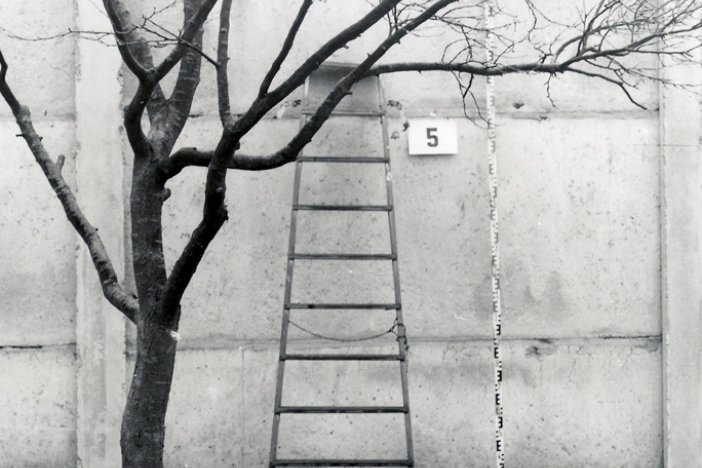The oldest section of the Berlin Wall
The breeze block wall at the East Side Gallery
The construction of the Berlin Wall in 1961 was initially provisional. An old piece of breeze block wall at the East Side Gallery bears witness to these beginnings.By Vincent Bruckmann and Hannah Schulz
The colourful breeze block wall at the East Side Gallery, 2 February 2022 (Photo: Vincent Bruckmann, CC-BY-SA)
There is no sign of Manfred Weylandt's escape on the Friedrichshain bank; a memorial plaque for him and other Wall victims stands on the Kreuzberg side on May-Ayim-Ufer. The former filter and carburetor plant has been replaced by an apartment and hotel complex. However, when observed very closely near the intersection of Stralauer Platz and Muhlenstrasse, the remnants of the wall of the former factory site are still visible. The existing property wall was constructed in 1961, eleven years before Manfred Weylandt's escape attempt, and fitted with shards of glass panes. It was intended to seal off the filter and carburetor plant from the open banks of the Spree River. It is one of the few remaining sections of the first construction phase of the Berlin Wall.
Border police and auxiliary workers erected the inner-city border starting in August 1961. Today, hardly any traces of this first construction phase of the Berlin Wall remain. Instead, the first images most people think of when they hear the word "Berlin Wall" are the 3.60-metre-high reinforced concrete elements with the pipe block tops, as can also be seen at the East Side Gallery. However, this construction of the Wall only dates back to the third phase of expansion, starting in 1975. Hidden at the northwestern end of the East Side Gallery, however, is a small section from the early days of the Wall's construction.
The start of the lockdown of West Berlin was initially very makeshift. Border police rolled out barbed wire in the streets or formed human chains at places like the Brandenburg Gate. Only after the GDR leadership had waited for international reactions from the West was the border fortification gradually solidified. From 22 August 1961, a total of about 18,000 people were involved in building the border fortifications, including employees of the "Volkseigene Betriebe (Publicly Owned Enterprise)" (VEB). They bricked up windows and building entrances through which East Berliners could enter the West.
On the premises of the filter and carburetor plant at Stralauer Platz, the border police also made escape more difficult by first constructing the existing property wall with breeze blocks. Additionally, attempts to escape were made more difficult by embedding glass shards in concrete on the wall. Some of these glass shards can still be seen at the top of the wall. Thus, the hollow block wall is still a reminder of the GDR's border regime and its victims, including Manfred Weylandt. This wall itself is painted with graffiti today. However, it is not part of the famous art action at the immediately adjacent East Side Gallery. Similar hollow blocks are in the collection of the Berlin Wall Foundation. Visitors can also see remnants in the "Haus der Geschichte" in Bonn or the Berlin exhibition of the Humboldt Forum. However, to see the first form of the Berlin Wall in its original place, it can be found at the East Side Gallery.
This text is published under the Creative Commons license "CC BY-NC-ND 4.0". You may share the text by mentioning the license CC BY-NC-ND 4.0 and the authors. Copyright information for the images can be found in the image captions.


